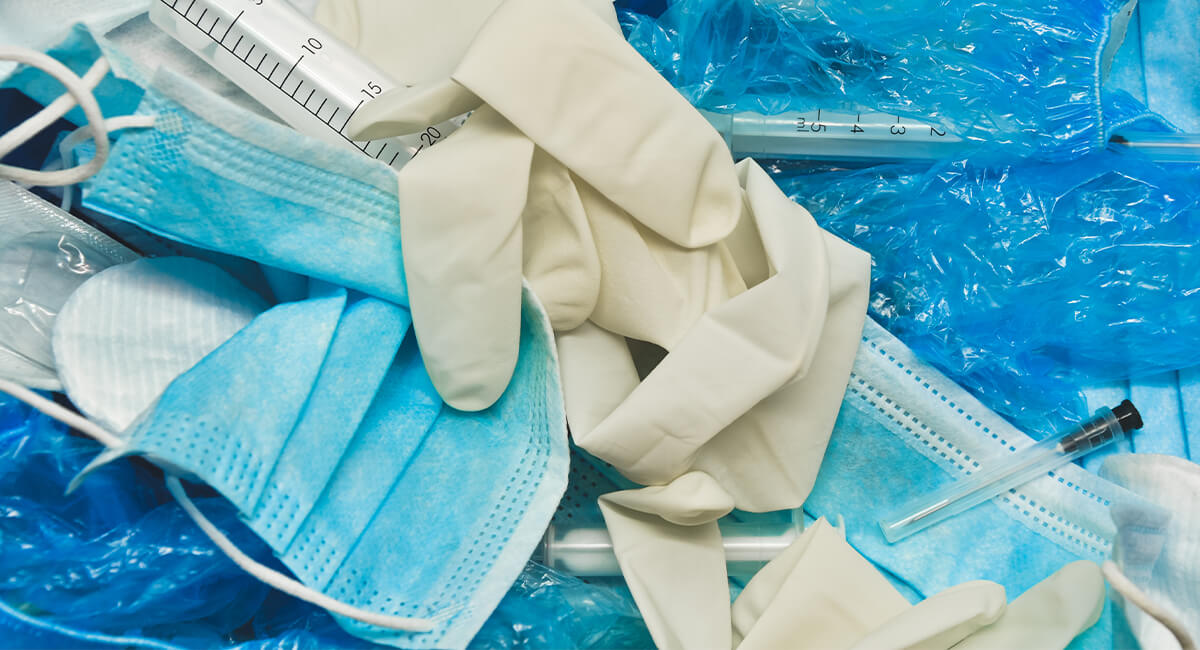The Double-Edged Role of Plastics in Global Healthcare
Article Summary
Medical-grade plastics are essential in healthcare for their safety, biocompatibility, and cost-effectiveness, but their single-use nature creates major environmental and health concerns. Biobased alternatives and small behavioural changes, like reducing unnecessary device use, can significantly cut waste and carbon emissions.Article Contents
How do Plastics Benefit and Burden Healthcare?
Medical-grade plastics are one of the most commonly used materials in medical devices due to them having numerous advantageous characteristics. Examples of such plastics include polycarbonate, polypropylene, acrylonitrile butadiene styrene (ABS), and etc. Medical-grade plastics have a wide variety of uses across the healthcare sector. However, such a presence comes with growing environmental concerns surrounding the disposal of single-use items containing these plastics.
For example, in 2020, it was estimated that the UK National Health Service disposes of approximately 133,000 tonnes of plastic each year, with variations between countries often relating to the “differential use of single-use plastics”. In addition to environmental concerns, medical-grade plastics have also instigated fear with regards to human health. For instance, Bisphenol A (BPA), a chemical found in some plastics, has shown to have caused endocrine disruption with the potential of causing further reproductive, developmental and neurological issues. Such research indicates that there is a growing need to raise awareness for unnecessary plastic consumption through finding sustainable alternatives or different disposal methods which can replace the need for plastic or reduce the amount of single-use medical devices, made from plastic, within the healthcare sector.

Why Are Plastics So Widely Used in Medical Devices?
One of the predominant reasons for the reliance on medical-grade plastic, in medical devices, is due to their ability to be biocompatible. Biocompatibility refers to the capability of a material to interact with a living system without eliciting an immunological or toxic response, thereby allowing it to perform its intended function. Whether that be for various biological applications or medical therapy. However, achieving such biocompatibility requires a meticulous selection and testing process, often using medical-grade polymers like polyethylene (used in prosthetics and implants) and fluoropolymers (often used in catheters) which are known for their wide temperature tolerance and lubricity.
Another reason for the reliance on medical-grade plastic, in medical devices, is the ability for easy sterilisation, which is essential if intended for critical use. Medical-grade plastics are formulated in a way that provides them with high levels of resistance to both heat and chemicals, as well as radiation, enabling them to undergo sterilisation without losing their structural integrity or dimensional stability. Such plastics are often used in a plethora of single-use plastic medical devices, including syringes and catheters which make up around “1/3 of waste in intensive care or anaesthetics”. Therefore, whilst the material is both effective and reliable when it comes to sterilisation, alternatives need to be sort after if we are to tackle their associated waste issues.
Lastly, medical-grade plastics are cost-effective when compared to other materials like platinum, titanium, nanoparticles and smart textiles. Their lower production costs allow for mass production, improving both the accessibility and affordability of medical devices within healthcare. It is these low costs of production that promote the financial viability of single-use plastic items like catheters and syringes, therefore enabling sterile environments to be easily maintained by enhancing the ability to control and minimise the transmission of infections . Additionally, further cost reductions can be reaped from reduced transport risks as it is safer to transport plastics over fragile items like glass, therefore minimising breakages and associated costs. However, despite such savings, it is paramount that we begin to shift away from fossil-fuel-based plastics, if we are to tackle the environmental footprint of the healthcare sector.

Can Biobased Materials Replace Traditional Plastics in Healthcare?
With the rise in concern over fossil fuel consumption and its environmental impact, there has been a shift away from plastic, towards biobased alternatives which are typically made from plants, algae or agricultural waste. Due to their naturally-occurring nature, they play a pivotal role in sustainable manufacturing, allowing for the development of a renewable resource base which reduces the dependence on finite fossil fuels. Additionally, such materials can also promote sustainable waste management whereby, for single-use medical devices like syringes, biobased plastics are able to offer an alternative pathway through industrial composting or anaerobic digestion. When incinerated, their carbon stores are reabsorbed by plants, aiding in the creation of a more circular and carbon-neutral process compared to the emissions produced through burning plastic. In the long run, these biobased alternatives actually stand as an economic incentive due to the reduced dependence on volatile oil markets and lower expenses related to waste management. Consequently, this allows for funding to be directed elsewhere, such as for treatment innovation or crucial diagnostic research.
Whilst biobased materials demonstrate clear advantageous characteristics over their plastic counterparts, they are not without shortcomings. For example, due to biobased materials often lacking consistency and durability, it is usually hard for them to meet the strict regulatory compliance levels which ensure medical devices meet safety and performance regulations. However, in 2022, Okos Diagnostics, a green diagnostic start-up, was the first company to introduce and patent a biodegradable universal cassette for external medical devices, like rapid tests. They state that their cassettes are made from plant-based materials which “match the strength of traditional plastics but break down naturally”. And because they are compatible with existing manufacturing, they can aid in the synergy between sustainability and healthcare.

How Can Hospitals Reduce Unnecessary Plastic Waste?
In 2021, the NHS committed to a short term reduction of 10%, with regards to clinical single-use plastics, after data showed that over 1.4% of NHS supply chain emissions are derived from single-use plastics. The unnecessary utilisation of single-use medical devices, made from plastic, can often be traced back to the cannulation that occurs in emergency departments. For example, at Charing Cross Hospital Emergency Department, it was found that “86% of patients attending a 24 hours consultant led A&E were cannulated… [with] over 40% of the cannulas inserted upon attendance… not [being] used”. Such excessive consumption was found to be costing the hospital around “£125,000 and generating an excess of 24,000 kg CO2 per year”, counteracting the cost-effectiveness of plastic, itself.
Instead of attempting to implement biobased or other recycled materials, Charing Cross Hospital decided to engage in the simple action of raising awareness through visual aids. Here, posters were designed to encourage staff to “’contemplate before you cannulate’”, as well as, developing a traffic light indicator to aid in cannulation decision making.
It was found that after 12 months, cannulation during emergency department attendance decreased by 25% with unnecessary cannulation falling by 13%, constituting to a cost saving of around £95,000 and a 19,000 kg CO2 reduction in associated carbon.
Whilst it is evident that there is a real need for alternative materials to plastic, within medical devices, it has been shown that even the simplest interventions can promote reductions in carbon emissions and, therefore, aid in environmental protection and sustainability.
References
- Rizan C, Mortimer F,Stancliffe R, Bhutta MF. Plastics in healthcare: time for a re-evaluation. J R Soc Med. 2020 Feb;113(2):49–53.
- Editor PPC. Excessive Plastic in Healthcare: The Growing Crisis [Internet]. Plastic Pollution Coalition. 2025 [cited 2025 Sept 16]. Available from: https://www.plasticpollutioncoalition.org/blog/2025/2/20/excessive-plastic-in-healthcare-the-growing-crisis
- Al. The challenges of recycling medical plastics [Internet]. 2024 [cited 2025 Sept 17]. Available from: https://plasnet.co.uk/challenges-recycling-medical-plastics/
- RecycleLab Ltd. RecycleLab Ltd. 2024 [cited 2025 Sept 18]. The Future of Medical Device Manufacturing: Available from: https://recycle-labs.com/whats-going-on/f/the-future-of-medical-device-manufacturing
- Okos [Internet]. [cited 2025 Sept 18]. Okos Diagnostics | Eco-Friendly Rapid Tests & Sustainable Diagnostics. Available from: https://www.okosdiagnostics.com
- NHS G. Greener NHS » Reducing unnecessary cannulation at Charing Cross Hospital [Internet]. 2021 [cited 2025 Sept 18]. Available from: https://www.england.nhs.uk/greenernhs/whats-already-happening/reducing-unnecessary-cannulation-at-charing-cross-hospital/
Disclaimer. The views and opinions expressed in this article are solely those of the author and do not necessarily reflect the official policy or position of Test Labs Limited. The content provided is for informational purposes only and is not intended to constitute legal or professional advice. Test Labs assumes no responsibility for any errors or omissions in the content of this article, nor for any actions taken in reliance thereon.
Get It Done, With Certainty.
Contact us about your testing requirements, we aim to respond the same day.
Get resources & industry updates direct to your inbox
We’ll email you 1-2 times a week at the maximum and never share your information
